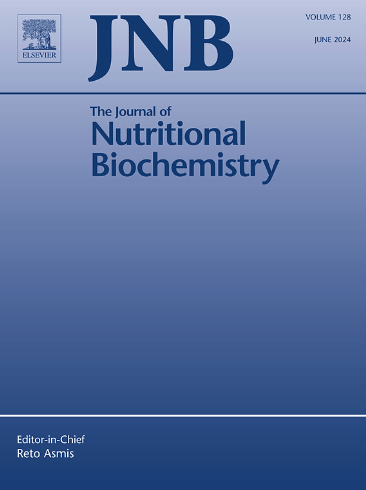高脂肪饮食限制成年雄性小鼠维持正常体重,但通过破坏线粒体氧化磷酸化导致肝脏损伤。
IF 4.8
2区 医学
Q1 BIOCHEMISTRY & MOLECULAR BIOLOGY
引用次数: 0
摘要
饮食限制(DR)主要通过对线粒体功能的影响来延缓衰老和支持健康。相反,含有过量卡路里的高脂肪饮食(HFD)会通过线粒体功能障碍促进肥胖和健康风险。然而,HFD在DR益处中的作用仍不清楚。本研究调查了持续性和间歇性DR伴HFD是否对肝脏和心脏健康有积极影响。将小鼠分为四组:随意进食(CTR)、随意进食高热量食物(H)、摄入60%高热量食物(HDR)和间歇性限制高热量食物伴体重循环(WC)。结果显示,与H组相比,HDR组和WC组的小鼠体重减轻,而两组动物的血糖水平都没有降低。肝脂肪变性、纤维化和NAFLD活性评分在H、HDR和WC小鼠中相似,但高于CTR小鼠。HDR和WC组小鼠肝脏也显示ATP含量降低,线粒体动力学相关蛋白表达改变。与肝脏CTR相比,H组动物肝脏LC3I表达降低,LC3II / LC3I比值升高。相比之下,HDR和WC组动物肝脏中p62、LC3I和LC3II的表达水平较低。在CTR和H组小鼠的心脏中观察到纤维化,DR没有逆转这种损伤。综上所述,尽管限制HFD维持了体重,但它通过破坏线粒体功能对肝脏健康产生不利影响。这些发现强调了在采用热量限制疗法时,膳食脂肪在肝脏健康中的关键作用。本文章由计算机程序翻译,如有差异,请以英文原文为准。
High-fat diet restriction to adult male mice maintains normal body weight but leads to liver impairment by disrupting mitochondrial oxidative phosphorylation
Dietary restriction (DR) delays aging and supports health primarily through its effects on mitochondrial function. Conversely, a high-fat diet (HFD) with excess calories promotes obesity and health risks via mitochondrial dysfunction. However, the role of an HFD in the benefits of DR remains unclear. This study investigated whether sustainable and intermittent DR with an HFD positively affects liver and heart health. Mice were assigned to four groups: chow diet ad libitum (CTR), HFD ad libitum (H), 60% HFD intake (HDR), and intermittent HFD restriction with weight cycling (WC). The results showed that the mice in the HDR and WC groups had reduced body weight, while animals in neither group had lower blood glucose levels compared to the H group. Hepatic steatosis, fibrosis, and NAFLD activity scores were similar in H, HDR, and WC mice but were higher than in CTR mice. The livers of mice in the HDR and WC groups also showed reduced ATP content and altered protein expressions related to mitochondrial dynamics. Liver in animals from the H group exhibited reduced LC3I expression and an increased LC3II to LC3I ratio compared with liver CTR. In contrast, livers of animals in the HDR and WC groups showed lower levels of p62, LC3I, and LC3II expression. Fibrosis was observed in the hearts of mice in the CTR and H groups, and DR did not reverse this damage. In conclusion, although HFD restriction maintained body weight, it adversely affected liver health by disrupting mitochondrial function. These findings emphasize the critical role of dietary fat in liver health when adopting calorie-restricted therapy.
求助全文
通过发布文献求助,成功后即可免费获取论文全文。
去求助
来源期刊

Journal of Nutritional Biochemistry
医学-生化与分子生物学
CiteScore
9.50
自引率
3.60%
发文量
237
审稿时长
68 days
期刊介绍:
Devoted to advancements in nutritional sciences, The Journal of Nutritional Biochemistry presents experimental nutrition research as it relates to: biochemistry, molecular biology, toxicology, or physiology.
Rigorous reviews by an international editorial board of distinguished scientists ensure publication of the most current and key research being conducted in nutrition at the cellular, animal and human level. In addition to its monthly features of critical reviews and research articles, The Journal of Nutritional Biochemistry also periodically publishes emerging issues, experimental methods, and other types of articles.
 求助内容:
求助内容: 应助结果提醒方式:
应助结果提醒方式:


